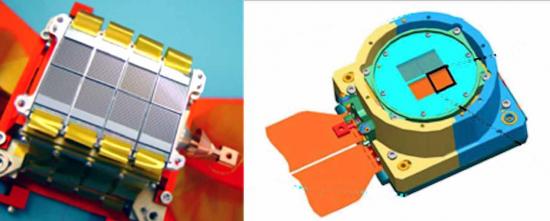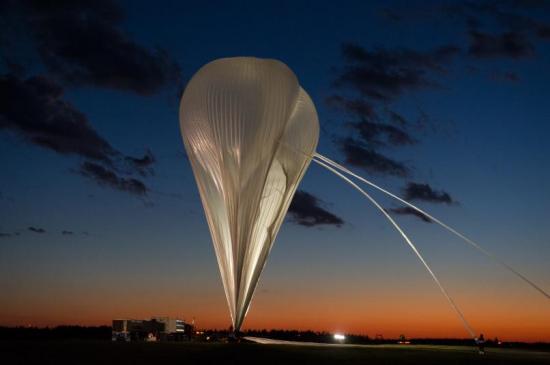The PILOT astrophysics experiment has been launched the 17th April under a stratospheric balloon from Alice Springs in central Australia. The aim is to observe the polarization of the emission of dust particles present in the interstellar medium of our Galaxy and the nearby galaxies. With a mass of nearly one ton, PILOT [1] uses the biggest balloons launched by the National Center for Space Studies (CNES). It was developed by the Institute for Research in Astrophysics and Planetology (CNRS / CNES / Paul Sabatier University) and the Institute of Space Astrophysics (CNRS / Université Paris-Sud) and the Institute of Research into the Fundamental Laws of the Universe (CEA-Irfu). Detectors capable of detecting infrared radiation from dust have been developed at the CEA and are the result of research done to realize the PACS camera that equiped the Herschel space observatory.
An infrared telescope 83 cm in diameter at the top of the atmosphere
The PILOT experiment consists of a mirror 83 cm in diameter equipped with instrumentation capable of recording cosmic emissions in the far infrared, at wavelengths around 240 and 550 micrometers.
It is equipped with two detector blocks, each comprising 4 matrices of 16x16 bolometers, for a total of 2048 individual detectors called bolometers. These detector matrices have been developed by CEA/DRF/Irfu of Saclay and CEA/LETI of Grenoble for submillimetric astronomy. They were originally produced to build the HERSCHEL satellite camera PACS (Photoconductor Array Camera and Spectrometer). They are based on the silicon micro-technology for the bolometric element, the CMOS technology for the first stage pre-amplifier and the integrated cold multiplexing circuit. The CEA has supplied the matrices as well as the associated hot and cold electronics. The two blocks are cooled to only 300 millidegrees above absolute zero by a helium refrigerator (3He).
On board PILOT, the polarization of light is measured by a rotating blade and a polarizer separating the light according to two orthogonal planes on the two bolometer blocks of the experiment. With the exception of the primary mirror of the telescope, the whole of the optics is maintained at a cryogenic temperature (2 ° Kelvin or -271 ° C) inside a cryostat cooled with liquid helium, to limit the instrument's own emission.
Measuring the properties of galactic dust
The emission of dust particles present in the interstellar medium of our Galaxy and nearby galaxies is weakly polarized because the dust grains are elongated and aligned with the magnetic field that bathes the interstellar medium. PILOT measurements will inform scientists about the nature of the dust grains and the processes that align them. They will also make it possible to map the geometry of the magnetic field, which plays a fundamental role in the contraction of the gas present in the interstellar medium leading to the formation of new stars.
Since this emission is also a nuisance for experiments measuring precisely the polarization of the cosmic diffuse background, Pilot's measurements will also allow a better knowledge of this emission and thus better interpret the results obtained by these experiments.
PILOT is launched by CNES as part of a campaign from Alice Springs in central Australia. The mass of PILOT approaches the ton and the balloon will have to reach an altitude of almost 40 km. At its maximum altitude, the inflated stratospheric balloon of 800,000 m3 of helium reaches a diameter of about 100 m in diameter (the largest open balloon launched by CNES).
The flight takes place during one of the two annual inversions of the stratospheric winds, a condition necessary to allow to make observations for more than 30 hours at the ceiling. The PILOT experiment has already been launched for the first time since September 2015 in Canada in the Northern Hemisphere. This new flight from the southern hemisphere will allow to observe exceptional astrophysical sources such as the Magellanic clouds, satellite galaxies of our own and also the regions of the the Milky Way center, inaccessible from the northern hemisphere.
See - the CNRS-CEA press release (14 April 2017)
- the CEA Department of Astrophysics website
- the IRAP website (Institut de recherche en astrophysique et planétologie)
[1] The PILOT experiment (Polarized Instrument for Long-wavelength Observations of the Tenuous interstellar matter) was devised and carried out by CNRS scientists and engineers at the Institute of Astrophysics and Planetology IRAP (CNRS/CNES/Paul Sabatier University) and the Institute of Space Astrophysics IAS (CNRS/Université Paris-Sud), with major contributions from the CNES (Toulouse), ESA, the La Sapienza universities in Rome (Italy) and Cardiff (United Kingdom) and the CEA-Irfu (Saclay) , which developed the focal plane and its electronic reading. The whole project is supported by the CNRS laboratories and by CNES funding.
• Structure and evolution of the Universe
• Institute of Research into the Fundamental Laws of the Universe • The Astrophysics Division (DAp)
• Cosmology and Galaxy Evolution group (LCEG) • Space Systems and Architectures laboratory • Spectral-imaging laboratory for space science • Study and development of space eletronic systems
• PILOT



